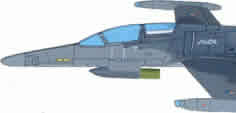In 1985, four years after the death of ‘Bill’ Wilmot, Roy and Julie Lever of the UK company Powermax discovered
a stock of original Jetex motors in the USA. These motors were of Sebel
manufacture, comprising steel-bodied 50Cs and 50R/HTs. However, since the
motors themselves were useless without fuel and fuse, the Levers themselves
undertook the manufacture of those essential items.
By the following year, 1986, Powermax was in a position to launch a range
of motors and fuel kits onto the UK market under the Jet-X
brand. In the October 1986 issue of Aeromodeller, Peter Freebrey
favourably reviewed the new fuel and fuse, having made a number of successful
text fights with a KeilKraft 'Space Jet'.
In the USA, although a number of enthusiasts had individually imported
Powermax supplies, it was not until August 1995 that the motors and new
fuel and fuse were commercially imported, by DARE Products, Inc. In that
same month, Flying Models, in an editorial by Bob Hunt, hailed
their arrival, enthusing that "safe and viable rocket power for model
airplanes is back".
With the run-out of the initial stock of Sebel motors, Powermax introduced
their own 'Z' series motors in the latter half of the 1990s. The range
was eventually extended to include motors of 100 and 35 size. These three
motors now comprise the current Jet-X product line in engines.
Though tales of uncertain ignition and variable performance continue to
plague the Jet-X scene, the Levers must be credited
with bringing the reloadable micro rocket concept back to practical life.
|
|
Introductory
advertisement for the Powermax Jet-X range


-
Aeromodeller, Oct. 1986 p. 597
|
With the new millenium came the Rapier range of motors, manufactured in the Czech Republic.
Unlike the reloadable Jet-X motors, these are strictly one-shot items. Essentially, they consist of
a cardboard tube filled with propellant and plugged with a ceramic end cap with a hole.
Currently, Rapiers are available in three power ratings: L1, L2 and L-2HP.
The earlier L-3 series has now been phased out of production, having been superseded by the
L-2HP which is identical in appearance to the standard L-2.
Though motors tend to vary somewhat in power from batch to batch, the duration of the L2
falls between 18 and 25 seconds. Fuses are included with each box of motors.
Rapiers are more reliable in their ignition than the Jet-X motors.
Dr Jan Zigmund, creator and manufacturer of Rapier motors has this to say about them:
The Rapier model jet propulsion units have been designed for sport and recreational flying
of jet powered model aeroplanes. The units are made of a cardboard tube with a refractory
nozzle and cover. The ideal thrust to weight ratio has been achieved by using suitable
simple materials for the construction of the jet unit tube combined with a special propellant.
This propellant has a low burning rate, low flame temperature and is able to burn at
low operational pressure in the cardboard combustion chamber. A long burning time and
consequent long flight time are of special interest to modellers of jet models.
We hope you have many happy hours of fun flying your models using the Rapier Model
Jet propulsion unit.
|
|
|
A Rapier-powered model



Dr Jan Zigmund




|